Matador Network's Blog, page 603
August 25, 2021
Save thousands on a luxury all-inclusive by leveraging the World of Hyatt credit card
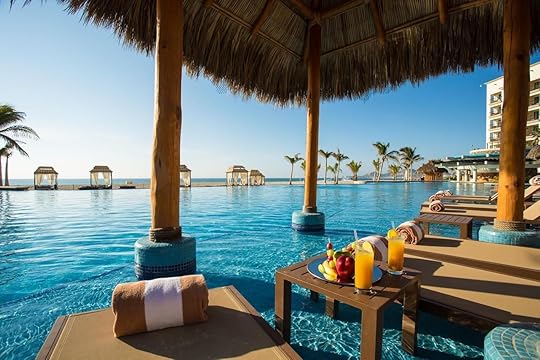
“I don’t want a free vacation” — said no one ever.
All-inclusive resorts have become increasingly popular, especially since the COVID-19 pandemic. Gone are the days of mediocre, soggy food and cringe-worthy rooms that all-inclusives used to be infamous for. Thousands of five-star all-inclusive resorts have popped up around the world, promising guests luxury experiences with gourmet dining and world-class bars, fun activities and high-end service. The only downside is these luxury hotels often come with a high price tag, but they don’t have to.
Just like you can earn thousands of points on your AmEx Platinum or your Chase Sapphire for your travel bookings, you can earn valuable points on the World of Hyatt credit card through Chase.
Right now, the sign up bonus of 60,000 points is enough to earn you three nights at the Hyatt Ziva in Los Cabos, Mexico or two nights at the flagship Hyatt Ziva/Zilara in Cap Cana, Dominican Republic among others. At 20,000 points/night and 25,000 points/night respectively, those bookings include everything, from your room, alcohol, food and non-motorized water sports. Cash rates at these properties can be astronomical in peak season, with the Cap Cana hotels coming in at no less than $650 USD per night, giving you a fantastic value for your points.

Photo: Voyager Guru
The World of Hyatt credit card also comes with Hyatt Discoverist status. While this status is by no means the highest tier, it can get you preferred rooms, priority reservations and generally more “appreciation” during your stay.
Compare the points redemption rates for Hyatt versus points redemptions at Hilton or Marriott. You’ll typically find much higher points rates, like 80,000 points per night at the Hilton La Romana. With Marriott, you can book a room at the Royalton Bavaro for 50,000-70,000 points for a standard room redemption. Right off the bat, you are saving tens of thousands of points and staying at a significantly higher end property in the Dominican Republic. The 25,000 points for the Hyatt Zilara Cap Cana is a far cry from the 50,000 or even 80,000 points for a comparable Marriott or Hilton resort and will take you much longer to save up for.

Photo: Hilton La Romana
I hear you saying, “I don’t want to stay at a hotel for just two nights?” Don’t worry, I got you.
There are a few easy ways to maximize your spend on the Hyatt credit card to generate you enough to book that weeklong or two week long getaway. The first may seem obvious: use this credit card when booking any Hyatt-affiliated hotels. However, what many people don’t know is that Hyatt has partnered with Small Luxury Hotels (SLH) to increase their footprint all over the world. This has greatly increased the number of available Hyatt properties worldwide.
You may be amazed to find out just how many of your favorite boutique hotels are now bookable via Hyatt and will earn you valuable points. Hyatt also acquired Two Roads Hospitality a few years ago, furthering their footprint around the US. Hyatt credit card members earn four additional points per dollar, on top of the five points earned as a World of Hyatt member. That means nine points per dollar on any hotel booking, restaurant or spa purchase at Hyatt hotels.
That wasn’t a typo, it’s really nine points per dollar spent.
Hyatt also offers two points per dollar on “getting around” with Uber/Lyft or commuting expenses. You also earn two points per dollar on dining, airfare and gym memberships. The airfare points per dollar is not as competitive as you can get from AmEx (five points per dollar) or Chase Sapphire (three points per dollar), but the gym membership is, in fact, a valuable offer. This includes fitness apps like Peloton and Equinox. All other purchases qualify for one point per dollar spent.
As you can see, it’s fairly easy to accrue points on the World of Hyatt credit card with everyday spending.
I know, I know…I hear you saying, “But I already have so many points sitting in my Chase account, what about those?”
Here’s a bonus pro tip for you, if you have the Chase Sapphire Preferred or Reserve, you can transfer your points from those cards to your World of Hyatt account at a 1:1 ratio, meaning one point on Chase is equal to one point on Hyatt to top off your points bank with extra points for your vacation. If you don’t have a Chase card, even better, sign up for the Chase Sapphire Preferred card with the insane 100,000 point bonus and transfer them all over to Hyatt (the sign up bonus is limited). Those points will earn you four to five nights at the aforementioned Hyatt Ziva/Zilara properties.
A luxury all-inclusive vacation may be closer than you think. If you’re looking for a credit card that will enable you to accrue points quickly and book a wide variety of all-inclusive resorts at an excellent value, look no further than the World of Hyatt credit card. 
The post Save thousands on a luxury all-inclusive by leveraging the World of Hyatt credit card appeared first on Matador Network.
August 24, 2021
Hawaii’s ultimate farm road trips for the best coffee, fruit, nuts, and chocolate
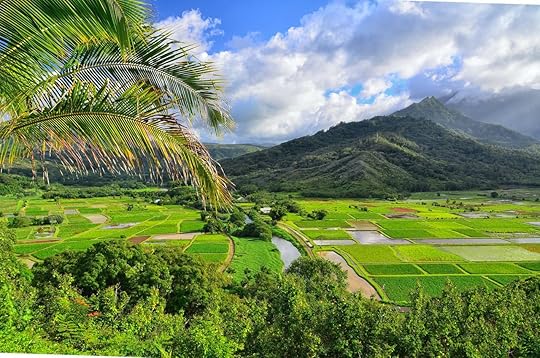
A road trip around the Big Island of Hawaii is the perfect way to try tropical treats found nowhere else in the United States. The Big Island is like few other islands in the world in that it packs eight of the planet’s 13 climate zones into an area just over 4,000 square miles — perfect for growing an abundance of delicious produce.
Farms and producers cater to the public by opening their gates, fences, doors, and hearts to show the process of growing these specialties, and, more importantly, allowing people to taste what’s growing. These three mini road trips will take you to farms where you can try the best of the coffee, tropical fruits, cacao, and macadamia nuts that grow in this island paradise.
Hawaiian coffee farm road trip
Kona Coffee is known for its distinct flavor that comes from the growing conditions on a 30-mile strip along the Hualalai volcano’s western slope, which is called the Kona coffee belt. A mixture of rich volcanic soil, warm and dry mornings followed by a late afternoon rain, and a limited temperature variance creates the perfect environment for coffee plants to thrive. Most coffee farms on the island are found along a stretch of the Mamalahoa Highway south of Kailua-Kona. When you take any tour, keep in mind you’ll be visiting active farms with potentially sloped and rocky terrain. Wear sturdy shoes and come prepared for inclement weather.
Start your road trip on Painted Church Road and check out Bay View Farm Coffee in the town of Captain Cook. Note that the road is a narrow, winding drive at an elevation of around 800 feet.
At Bay View Farm, the coffee bushes are planted below the visitor’s center on the sloping mountain leading down to the ocean. Five 30-minute tours are run every day from 1:00 PM to 3:30 PM, no reservation required, and there’s a gift shop and plenty of free parking. The tours include free tastings and the chance to walk right up to the plants and see the production facilities where the beans are dried, weighed, and roasted.
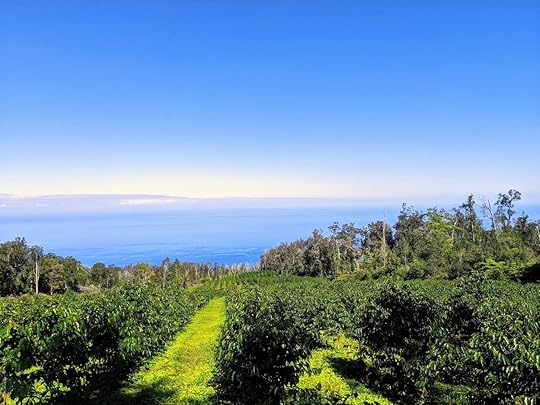
Photo: Hala Tree/Facebook
Next, head to Hala Tree Coffee Farm, an organic operation in the Kona coffee belt. Located on the mauka, or uphill, side of the highway, this farm grows, processes, and roasts its products on site. Hala Tree started in 2012, and the owners nurtured two neglected acres of coffee bushes into a thriving farm with a great view from the visitor’s platform. IT received USDA Organic Certification in 2015. Book a free tour online, or call ahead for groups larger than 12. Time the visit with a stop at The Coffee Shack for a meal with the best view of Kealakekua Bay.
From Hala Tree, make your way north to Greenwell Farms, a coffee farm started in the 1800s that’s still run by the same family today. As well as housing a coffee museum, it won Hawaii Magazine’s award for Best Farm Tour in 2021. Free tours are offered in English from 9:00 AM to 3:00 PM at the top and bottom of the hour, and in Japanese at 10:00 AM and 1:00 PM. Reservations are not required, but it’s recommended to show up 10-15 minutes before the tour you want to go on begins.

Photo: Greenwell Farm/Facebook
While the Kona coffee belt has the highest density of farms, there are coffee farms in other areas of the island. Take a drive from Kona to Honoka’a early in the morning and watch that famed Hawaiian light rise between Mauna Kea and Mauna Loa — the two largest volcanoes on the island — before reaching Long Ears Coffee on the 3B Half Horse Ranch. The Ranch has been there since 1970, and coffee plants have been on the land since 2000. Call or email to set up a tour, which costs $35 per person (there’s a two-people minimum for the tour to go on).
Bay View Farm Coffee: 83-5249 Painted Church Rd, Captain Cook, HI 96704, United States Hala Tree Organic Kona Coffee Farm: 82-5966 Hawaiʻi Belt Rd, Captain Cook, HI 96704, United StatesThe Coffee Shack Restaurant: 83-5799 Mamalahoa Hwy Box 510, Captain Cook, HI 96704, United States Greenwell Farms: 81-6581 Mamalahoa Hwy, Kealakekua, HI 96750, United StatesLong Ears Coffee: 46-3689 Waipahi Pl, Honokaa, HI 96727, United StatesHawaii’s fruit and cacao farms for fresh treats and chocolate
Yes, the Big Island is known for its coffee, but there are plenty of other farm tours focused on fruit and cacao that are just as desirable.
Kuaiwi Farm is located in the town of Captain Cook, south of Kona. The farm grows cacao, coffee, and macadamia nuts, as well as avocado, banana, and pineapple. Reserve ahead for the farm tour and tasting held Sundays and Tuesdays from 10:00 AM to 12:00 PM for $25 per person.

Photo: Starseed Ranch/Facebook
The northernmost regions of the island make for a beautiful and tasty road trip. Both North Kohala and the Hamakua Coast are lush with foliage thanks to abundant rainfall — a climate that also allows for farms to prosper. Call ahead to book a tour and table at Starseed Ranch just outside of Hawi. Starseed Ranch offers farm stays, dinner options, and a food, forest, and plant medicine tour. Stay the night after you hike the Pololu Valley — the trailhead is just around the corner. You’ll be well fed after the trek thanks to fresh mango, papaya, avocado, breadfruit, lemon, lime, coconut, turmeric, banana, plantain, and more. Farm tours are available Thursdays by request starting at $35 per adult and can include a farm-to-table dinner. Accommodations start at $125 per night.
Count waterfalls as you drive along the Hamakua coast and stop in at Big Island Farms, which grows more than 200 species of plants. Tours are available to see the farm and taste the coffee, banana, papaya, cassava, taro, ginger, turmeric, cacao, avocado, breadfruit, coconut, sugar cane, sweet potatoes, kukui, ti, and bamboo. Tours are $10 per person with a minimum of two people. Book ahead online.
Next, head through Hilo and make your way to O.K. Farms. It’s located just above Rainbow Falls and there are overlooks and walking trails throughout the rolling hills. As stewards of the land for over 20 years, O.K. Farms gives back to the community in part by supporting other farms with its Farm Box program, a subscription service that provides fresh food to the community. Book a tour to experience the view from the top of Rainbow Falls and taste the amazing produce grown here, including lychee, longan, rambutan, citrus, macadamia nuts, coffee, cacao, heart of palm, and more. Tours — 9:00 AM, 11:00 AM, and 2:00 PM — are booked in advance online and cost $52.36 per person.
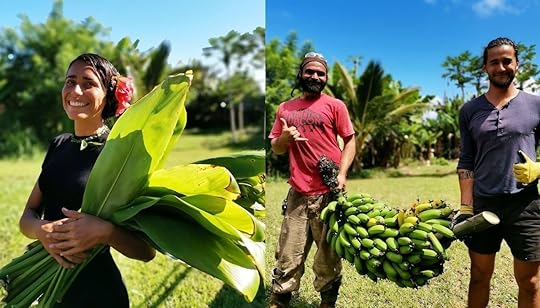
Photo: BIFarms/Facebook and BIFarms/Facebook
Continue a few minutes west and check out Kulaniapia Falls. The farm tours and cooking classes are offered Mondays, Wednesdays, and Fridays starting at 9:30 AM. You’ll tour the gardens and learn culinary skills to create a fresh lunch where you can taste some of the dozens of products grown on site. Prices start at $149 for Inn guests, or $199 for the public, and include access to the falls after class. Overnight guests can also hire a private chef to create a fresh, in-season menu for dinner. The cost is $99 per person for a four- to five-course meal. Accommodation prices vary.
Farther south in the Puna region, you’ll find Puna Gold Estate. There, you can indulge in tropical fruits such as papaya, pineapple, bilimbi, guava, rambutan, lilikoi, avocado, bananas, thimbleberries, poha berries, jabuticaba, loquat, starfruit, and much more, as well as coffee and cacao. Call ahead or book online and you’ll receive exact directions to the farm. Tours are $25 per person and begin at 1:00 PM every day except Mondays.
Kuaiwi Farm: 82-6155 D Rd, Captain Cook, HI 96704, United StatesStarseed Ranch: 52-4700 Akoni Pule Hwy, Kapaau, HI 96755, United StatesBig Island Farms: 47-4667 Honokaa-Waipio Rd, Honokaa, HI 96727, United StatesO.K. Farms: 1570 Maikalani St, Hilo, HI 96720, United StatesKulaniapia Falls: 100 Kulaniapia Dr, Hilo, HI 96721, United StatesPuna Gold Estate: Exact address available upon booking to reduce drop-in visitors. Not included on the map.A road trip tour of Hawaii’s famous Macadamia nut farms
Macadamia nuts were first brought to Hawaii from Australia in the late 1800s, and almost all macadamia nuts in the state are grown on the Big Island. In fact, one of largest macadamia nut orchards in the world is MacFarms in South Kona. While it isn’t open for tours, there are other farms and centers throughout the island where you can watch the process and taste nuts. Some farms listed above include macadamia nuts, but here are some nut-specific spots to hit.

Photo: barmalini/Shutterstock
Mauna Loa, with a visitor’s center outside of Hilo, creates Hawaii-specific flavors of nuts such as Kiawe smoked barbecue, Maui onion and garlic, and Hawaiian sea salt. It also has a variety of chocolate-covered macadamia nuts and dairy-free macadamia nut ice cream. Check ahead to make sure the visitor center is open.
The Hamakua Macadamia Nut Company grows and processes nuts all year round. The visitor’s center is at the farm on the north tip of the island. It’s open daily except major holidays from 9:00 AM to 4:30 PM, and you can partake in a tasting and, depending on the day, watch the cannery process. Call ahead to confirm hours of operation.
Mauna Loa Macadamia Nut Visitor Center: 16-701 Macadamia Road, Keaau, HI 96749, United StatesHamakua Macadamia Nut Company: 61-3251 Maluokalani St, Waimea, HI 96743, United States More like thisSpirits + CocktailsThis rum distillery is helping Hawaii’s heirloom sugarcane thrive once again
More like thisSpirits + CocktailsThis rum distillery is helping Hawaii’s heirloom sugarcane thrive once againThe post Hawaii’s ultimate farm road trips for the best coffee, fruit, nuts, and chocolate appeared first on Matador Network.
Watch: This Qantas commercial about the return of travel will give you all the feels

Qantas Airways’ latest commercial tugs at the heartstrings in the hope to encourage more Australians to get vaccinated against COVID-19.
While many other nations have opened their borders to foreign tourists, Australia’s have remained closed since the onset of the COVID-19 pandemic in March of 2020. Besides a brief period where the country created a quarantine bubble with New Zealand, most Australian residents have remained at home, missing out on time with friends and family living outside the country, as well as international family vacations. And the limitations on travel will stay this way until the country reaches an 80 percent vaccination rate, Reuters explains.
The new commercial is part of Qantas’ “Be Rewarded” campaign, which offers discounts and incentives like Qantas points to vaccinated customers.
On Twitter, Dr. Nick Coatsworth, an infectious diseases physician and Australia’s former deputy chief health officer applauded Qantas’ commercial. “This is how you get people looking forward to what a vaccinated society looks like. Nice work @qantas,” he said.
This is how you get people looking forward to what a vaccinated society looks like. Nice work @qantas https://t.co/fRl3rYUdtL via @YouTube #covid19aus #eightypercent #auspol
— Dr. Nick Coatsworth (@nick_coatsworth) August 23, 2021
The emotional commercial also brought many to tears.
Ugh. Now Qantas has made me cry. And not for the usual reasons https://t.co/SEOrkgGYzc
— Amy Remeikis (@AmyRemeikis) August 23, 2021
Anyone not crying at the Qantas ad?
— Kumi Taguchi | 田口久実 (@kumitaguchi) August 23, 2021
As of August 24, 2021, only 24 percent of Australia’s population has been fully vaccinated, according to Our World in Data. 
The post Watch: This Qantas commercial about the return of travel will give you all the feels appeared first on Matador Network.
The first Europe to Asia thru-hike is coming, and you can help build it
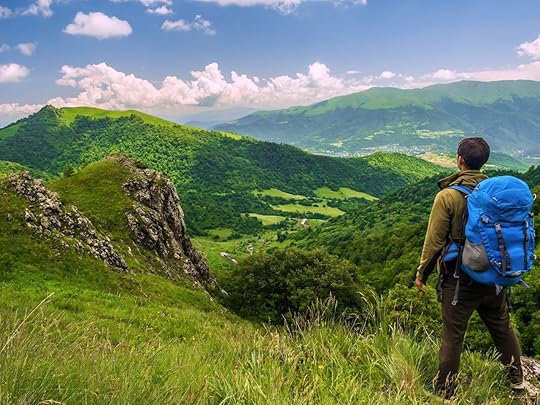
The first major trek connecting two continents opens soon. By the summer of 2022, you’ll be able to hike north to south across Armenia. A few years later, you’ll be able to hike a triumphant route across the entire Caucasus Mountains, connecting Europe and Asia in one long, 1,864-mile behemoth of a path called the Transcaucasian Trail.
When finished, this trail will connect four countries and more than 20 national parks and UNESCO heritage sites. It will also include climbs on some of the region’s tallest peaks, including Armenia’s Azhdahak and Khustup mountains. The TCT, as we call it, is set to earn its ranks among the world’s greatest treks. Here’s what to know about the trail and how you can get involved.
What is the Transcaucasian Trail, and how did it come to be?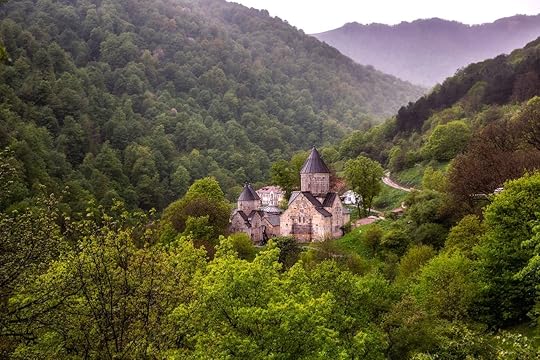
Photo: Mike Ilchenko/Shutterstock
The trails are the result of a coming-together for the ages. Trail advocates and volunteers with the Transcaucasian Trail Association have been working on linking an epic connection of established trails, old Soviet Jeep routes, and new trails together into what will be a thru-hike on par with the Pacific Crest Trail and Appalachian Trail in terms of sheer dedication required. The TCT has the potential to amplify the status of a region often overlooked by international trekkers who flock to the Himalayas and Patagonia. Nowhere else does one thru-hike connect two different continents.
When finished, it will actually be a combination of two major trails. A north-south route will run from the peaks of Georgia south through Armenia to the border with Iran. The east-west route will connect the Black and Caspian Seas through Georgia and Armenia. About 750 miles of the north-south route is expected to open in the summer of 2022, with several years of work left on the east-west route. Hikers can expect to spend upward of 40 days or more on this section of trail, camping and staying in villages en route. Matador reported on specifics regarding the trail and other things to do in Armenia when news of the trail first broke.
How you can help the trail come to life
Photo: Jan Nedbal/Shutterstock
One of the most exciting aspects of the Transcaucasian Trail is that you can help make it happen. The primary way to do so is by becoming a member of the Transcaucasian Trail Association. $100 buys you a basic annual membership to the association, though a donation of that size is not required. The group accepts donations via its website, with tiered breakdowns beginning at $10 and ranging up to $1,000, for which you’d be supporting the construction and five years of maintenance on an entire section of the trail.
If you happen to be in the greater Caucasus region (or plan to travel there in the future), you can also join a summer volunteer camp. Volunteering is a great way to actually see the trail while helping bring it to life. Work involves basic trail building and digging, and while you’re sure to sweat through your shirt, the association promises an engaging experience and a chance to meet other people who are as passionate about trekking as you are.
Volunteering or becoming a member of the Transcaucasian Trail Association also gives you access to attend Supporters’ Treks. These are special outings where those who helped are rewarded by being the first to experience sections of the trail. 
The post The first Europe to Asia thru-hike is coming, and you can help build it appeared first on Matador Network.
How to make the most of your trip to the ‘Niagara Falls of the West’
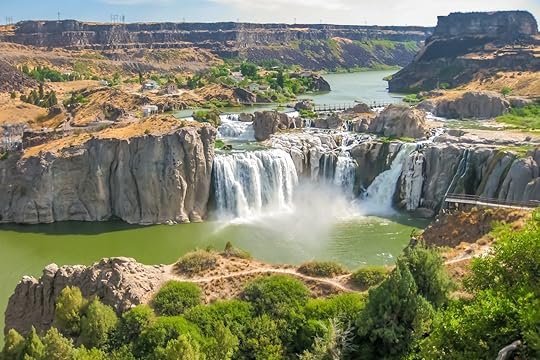
When you think of waterfalls in North America, there’s a good chance that Niagara Falls is top of mind. While those falls are certainly majestic, they’re not even close to the highest. Falls in Yosemite and Hawaii are also easy to point to. Waterfalls in Idaho, however, probably don’t crack your top 10. Well, they should.
Idaho is home to some of the country’s most stunning natural beauty, not least of which is Shoshone Falls. Dubbed the “Niagara Falls of the West,” Shoshone sits just outside Twin Falls, Idaho, and it surpasses Niagara in height by nearly 50 feet. While the falls themselves are an ideal destination for sightseeing, the broader Twin Falls area is perfect for those craving outdoor adventure, and a solid brewery and culinary scene. From kayaking the Snake River Canyon to exploring the city of Twin Falls itself, here’s how to make the most out of your visit to the Niagara Falls of the West.
Shoshone FallsAt 212 feet high and 900 feet wide, Shoshone Falls is one of the most beautiful waterfalls in the US. The falls are located just seven miles outside Twin Falls, a city of just under 50,000 people in southern Idaho. They were created around 15,000 years ago during the Bonneville Flood of the Pleistocene ice age, when the water that covered much of the Great Basin carved the Snake River Canyon and created Shoshone and other regional waterfalls.

Photo: Jeremy Janus /Shutterstock
To get the best view of the falls, your first stop should be one of the observation decks. The first deck is located at the park’s entrance and is accessible via a set of stairs. From here, you can get an unparalleled bird’s eye view of the falls. The second viewpoint affords a wider and closer view, and is located farther up the path from the entrance. You can also consider taking one of the hiking trails around the falls, which begin in nearby Dierkes Lake Park or Centennial Park. The Canyon Rim Trail, for example, is a 12-mile trail from the western side of Twin Falls to Shoshone Falls. There’s also the easy Shoshone Falls Observation Deck Trail and the slightly more challenging Dierkes Lake Trail, which is often steep and damp.
Truly adventurous visitors might crave an up-close look at the falls, which is best obtained via kayak. Move over Maid of the Mist: You can kayak to the bottom of Shoshone for a stunning (and terrifying) view of the thundering falls. Rent a kayak from AWOL Adventure Sports in Centennial Waterfront Park, and paddle for two to three hours down the Snake River to Shoshone. Along the way you’ll see Pillar Falls, pass under the Perrine bridge, and take in the views of the canyon before finally arriving at the imposing waterfall.
Explore Snake River CanyonShoshone Falls might be the visual highlight of the area, but Snake River Canyon is definitely the adventure highlight. Whether it’s hiking, boating, stand up paddle boarding, kayaking, canoeing, rock climbing, or even golfing, there are no shortage of activities to keep you busy in the canyon.
Snake River Canyon extends over 50 miles, features two waterfalls and several springs. The canyon might sound familiar to adrenaline fans as the site of Evel Knievel’s 1974 infamous jump, which proved unsuccessful. The Perrine Bridge, which crosses the canyon 500 feet from the bottom, is popular among base jumpers as the only place in the US open to base jumping year-round.
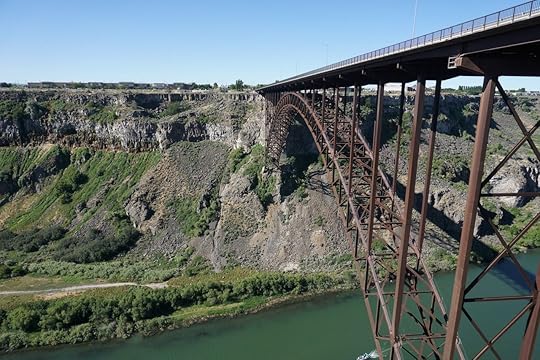
Photo: Sundry Photography/Shutterstock
One of the best ways to explore the canyon is the hiking path to Pillar Falls. It begins on Pole Line Road in Twin Falls, where you’ll find a dirt pull-off to park. From here, descend to the bottom of the canyon, where you’ll feel the refreshing spray of Pillar Falls. You can also take the trail to a section of the canyon farther east, on rugged terrain through trees and bushes. You’ll eventually arrive at a shaded camping area near the shore. You’ll also see a rock-stepped path in the water, which leads around the canyon wall. Once you clear the wall you’ll be rewarded with views of the Perrine Bridge and water cascading down the rock face.
You can also explore the nearby Hells Canyon — the deepest river gorge in North America — on an unforgettable jet boat tour. The tour begins at Pittsburg Landing, and heads upriver to see the Bighorn Sheep and other wildlife that call the canyon home. You’ll stop at the Kirkwood Ranch and Museum, Sheep Creek Cabin, and other points of historic interest. The trip continues upriver to Rush Creek, Granite Creek, and Hells Canyon Dam, where you’ll be able to swim in the calm pools to cap off an eventful day.

Photo: CSNafzger/Shutterstock
Don’t leave the canyon area without stopping at Dierkes Lake, located inside the canyon just a mile away from the waterfalls. The calm lake is known for its swimming, fishing, hiking, and boating, while the surrounding 191-acre park is perfect for holding a family barbecue or picnic. Only non-motorized boats are allowed on Dierkes Lake, so you’ll have to stick to paddle boards, canoes, and kayaks. The lake is also one of the most popular destinations in the state for scuba divers, as its deep waters hold curiosities like sunken rowboats, a metal shark cutout, and a hidden treasure chest.
Don’t forget downtown Twin Falls
Photo: Milner’s Gate/Facebook
While you can’t go wrong spending most of your time at the falls or Snake River Canyon, it would be a mistake not to check out what the Twin Falls has to offer. For a relatively small city, Twin Falls has a thriving craft beer scene. KOTO Brewing Co. is owned by a family with deep roots in the Twin Falls community, with the building itself infused with pieces of the city’s history. Then there’s Milner’s Gate, a brewery and full bar and restaurant that’s named after the Milner Dam completed in 1905.
Your trip can take a more educational turn at the Herrett Center for Arts and Science. Located on the campus of the College of Southern Idaho, this museum of natural history has an impressive collection from the prehistoric Americas. These include geological specimens, material relics of the Buffalo Nation, and artifacts from Peru that date back to before the Inca. The museum also houses the Faulkner Planetarium, the largest in the state with one of the biggest wheelchair-accessible public telescopes on Earth.
You don’t have to kayak through Snake Canyon to get a healthy dose of the outdoors on your visit to Twin Falls, either. Rock Creek Park, on the southwestern edge of the city, has 12 acres of green park land running alongside the canyon. You can follow the Old Towne Parkway Trail from downtown Twin Falls through the park, or take advantage of facilities like a disc golf course, fishing holes, horseshoe pits, picnic tables, and volleyball courts.
If you happen to be visiting the area in early September, you’re in luck. The Twin Falls County Fair runs for five days at the beginning of September (the first through sixth in 2021), and has been a popular event since 1916. The fair has all the classics like vendors, carnival rides, livestock competitions, and country music concerts, but it also coincides with the Magic Valley Stampede PRCA Rodeo. If you’ve never been to a rodeo before, here’s what to expect. Just know that alone might make the trip worth it. 
The post How to make the most of your trip to the ‘Niagara Falls of the West’ appeared first on Matador Network.
What travelers with a bleeding disorder need to know before their trip

In addition to purchasing travel insurance, booking accommodations, and getting up-to-date on immunizations, people with a bleeding disorder, such as hemophilia or Von Willebrand disease, need to take extra precautions before setting out on a travel excursion. Whether it be a short business engagement or a multi-week escape from home, follow these tips to keep your travels safe and smooth.
Talk to the Hemophilia Treatment CenterThere are over 140 federally-funded Hemophilia Treatment Centers (HTC) located across the United States of America that provide specialized care for individuals with bleeding disorders. The staff at your regional HTC are medical professionals who are trained in treating bleeding disorders. They are your go-to contact and will answer any and all questions about traveling. The HTC will also provide you with a travel letter for your trip. This letter will explain your condition and the necessity of your medication and accompanying supplies. It will stay with your medication and is useful as a reference if you are stopped at a security checkpoint. Moreover, the HTC can help you get a medic alert bracelet or necklace, which will allow emergency personnel to identify your bleeding disorder and get you the medical treatment you need.
Your regional HTC can also help navigate the HTC Directory for Hemophilia Treatment Centers, and find the nearest center to your travel destination. Save the contact information for your current HTC and the nearest HTC to your destination, just in case. Traveling internationally? Use the World Federation of Hemophilia’s Global Treatment Centre Directory, for a list of HTCs worldwide.
Always plan ahead
Photo: ALPA PROD/Shutterstock
Regardless of your mode of transportation, keep your medication and supplies with you at all times. Likewise, carry a copy of pertinent medical information — health insurance cards and prescriptions — with your medication. Store it in the same place as the travel letter from the HTC for easy reference. Familiarize yourself with the Center for Disease Control website, Travel Safe with a Bleeding Disorder, as the site has a lot of great information. Additionally, further your education and read The National Hemophilia Foundation’s, Travel and Vacation Planning. This extensive document goes over everything travel-related, from safely storing medication to communicating with unfamiliar ER physicians.
While preparing to travel, plan on bringing all of the medication and supplies that you need for the trip. Plus, additional medication and supplies for unforeseen travel delays or emergencies. The HTC can help determine how many doses to bring. Also, ask your pharmacy for a small travel-sized Sharps container to safely dispose of used needles. Remember to bring everything by making a checklist, or print the one you found on the CDC website. Triple-check that you’ve packed everything. No one wants to ruin a vacation because they ran out of syringes or alcohol pads. Besides, needing to receive medication at the hospital because you didn’t bring enough is very costly and time-consuming. There is also no guarantee that the hospital will have medication for your bleeding disorder on hand. Don’t risk it. Bring more than you need.
If you will be gone for weeks or months, consider having the pharmacy ship large quantities of medication to where you are staying. Admittedly, this can be a bit trickier to do internationally. Speak with your pharmacy. While traveling internationally, CDC guidance for a bleeding disorder recommends, “having an additional copy of the travel letter written in the primary language of the country you are visiting.” This can save time and the headache of tracking down an interpreter.
Navigating the airport
Photo: kitzcorner/Shutterstock
Joosh Namnehi has traveled domestically and internationally. He has journeyed to India and the Philippines to support the Hemophilia Federation of India and the Hemophilia Advocates for the Philippines, respectively. He also has severe hemophilia. His advice: “Don’t worry about anything. Everyone at the airport can identify medication and isn’t worrying about factor (anti-hemophilic medication).”
While traveling on an airplane, keep your medication and supplies in a carry-on bag as medication should not be kept under the plane for a variety of reasons. Vials could break, temperature changes might affect the efficacy of the product, or your luggage could be lost. Plus, there may be a chance that you will need treatment while traveling. “Always keep a box accessible on your carry-on, because transpacific and transatlantic flights will be 13 hours until you see the ground again,” suggests Mr. Namnehi.
Yes, medication and supplies can take up significant space. Fortunately, your personal travel bag of medical necessities doesn’t count against carry-on restrictions. The CDC website Travel Safe with a Bleeding Disorder states, “Medicine and medical supplies are exempt from airline baggage restrictions.” Make it easier on yourself and the airport security officers by keeping your medication, supplies, and medical documents in a clear bag that you can easily remove from your carry-on. Help make medication easy to identify by leaving it in the original packaging. Furthermore, deal with unexpected security delays by arriving early to the airport, or apply for TSA PreCheck and breeze through security.
“Today, most airports and airlines have plenty of amenities for anyone traveling with special needs. All you have to do is ask,” says Clay Gorham, a commercial airline pilot with mild hemophilia. Waiting in long lines, traversing terminals, and sitting for extended periods of time can wreak havoc on knees and ankles. Save your joints by asking for a golf cart or wheelchair escort to the gate. Mr. Namnehi says, “Always ask for a wheelchair escort. Some airports, internationally, require a reservation for them. Kuala Lumpur (in Malaysia) is one. That was a tough lesson.”
Treat the morning of the flight, or at the very least, know your prophylactic regimen and know your body. It’s no fun to infuse in the plane’s lavatory because of an unexpected bleeding episode. If you do need to treat at the airport, please, safely dispose of any used needles. Sharps containers are available in most airport bathrooms in the United States.
We all know we should be moving more, but what if you’re stuck on a flight? Sitting for extended periods of time is tough on the body as blood flow stagnates and joints stiffen.
Book an aisle seat, or an emergency row, and use that extra space to your advantage. Practice couch calisthenics and stretch those stiff appendages. Pace the aisles and move the blood in the legs. Sure, you might look silly. But, your body will appreciate it.
It may seem overwhelming, but with proper planning, traveling with a bleeding disorder is a breeze. Talk to your HTC, plan ahead, and explore.
The post What travelers with a bleeding disorder need to know before their trip appeared first on Matador Network.
Watch: World’s fastest-accelerating roller coaster closes after riders break bones
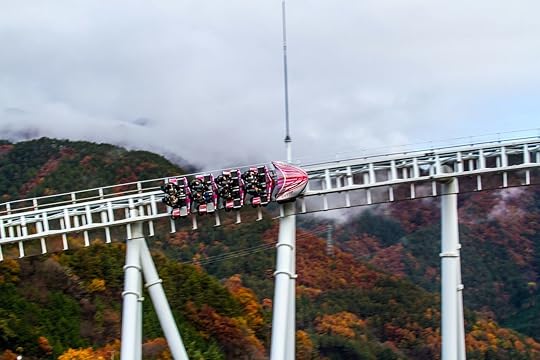
Japan’s Do-Dodonpa roller coaster, known as the world’s fastest-accelerating roller coaster and the fastest in Japan, is closed until further notice.
The roller coaster is one of many attractions in Japan’s Fuji-Q Highland, a theme park located at the foot of Mount Fuji. Do-Dodonpa can reach speeds of 111.8 miles per hour and can go from zero to 111.8 miles per hour in just 1.56 seconds — “super death” acceleration, according to the theme park’s website.
The world’s fastest-accelerating roller coaster has shut down indefinitely after riders reported several injuries when on the ride between December 2020 and August 2021. CNN reports that four people have sustained injuries, including a cervical fracture and a thoracic spine fracture. A link between the ride and the injuries has not been confirmed yet.
A press release by the theme park explains that “‘Do-Dodonpa- Fastest Roller Coaster’ will be suspended for the time being from August 12, 2021 (Thursday) due to a safety overhaul.’
Do-Dodonpa, the world’s fastest-accelerating roller coaster, also has the world’s largest loop with a 130.2-foot diameter at 164 feet above ground. 
The post Watch: World’s fastest-accelerating roller coaster closes after riders break bones appeared first on Matador Network.
August 23, 2021
At this Costa Rica hideaway, the real luxury is seeing abundant and rare wildlife

Cahuita is a small, unassuming town on Costa Rica’s Caribbean Coast. It may not be for everyone, but it’s perfect for those who choose wildlife over nightlife and prefer a basic cabana on an untamed stretch of sand to a luxury resort.
In Cahuita the jungle-backed beach is left as nature intended and is devoid of sun-lounging tourists. From tree frogs to sloths, wildlife is abundant – you never know what you might spot in the trees as you stroll along the dirt track which runs alongside the beach. “Downtown” holds just a couple of grocery stores and a scattering of Caribbean restaurants.
Cahuita is a laid back, unpretentious enclave with a strong Rasta influence and unique vibes. Not only does the town have a certain ramshackle charm, but it also happens to be located on the doorstep of a beautiful national park brimming with sloths, monkeys, and toucans. In fact, the entrance to Cahuita National Park is a mere stone’s throw from one of the supermarkets. The combination of a chilled-out Caribbean town and sublime national park is too much to resist for many travelers, who tend to linger far longer than intended.
Cahuita National Park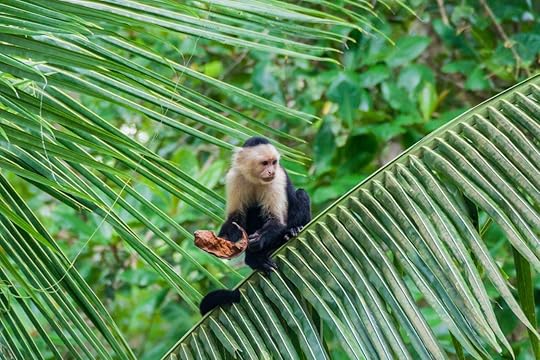
Photo: Matyas Rehak/Shutterstock
Covering 57,500 acres of land and sea, this national park includes 600 acres of living coral reef as well as beaches and jungle. A five-mile trail hugs the coastline with lush tropical rainforest on one side and views of the Caribbean Sea on the other. Gigantic electric blue morpho butterflies flit past, while monkeys watch on and coatis forage in the undergrowth. Slightly more elusive, but not impossible to spot, are the two- and three-toed sloths who hang around in the trees. When the jungle heat becomes too much, there are plenty of opportunities to hit the beach and indulge in a refreshing dip.
SnorkelingThe protected barrier reef is home to an abundance of marine life, including hundreds of fish species and 35 species of crustaceans and live coral. Angelfish, barracudas, and stingrays are amongst the aquatic creatures to inhabit the reef. It is also a nesting area for sea turtles. Because the area is protected, snorkelers are not allowed to go alone; they have to take a tour. The best times to visit the reef are between March and May or August and October. Several companies arrange snorkeling tours, and some of them combine a hike through the park.
Sloth Sanctuary of Costa Rica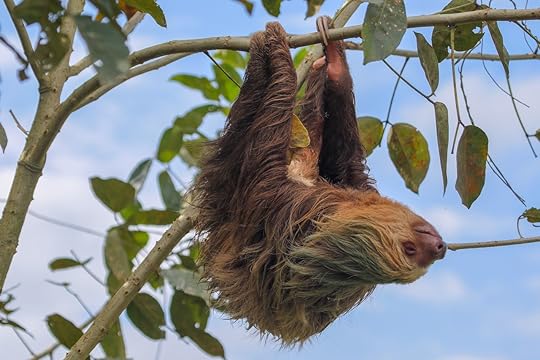
Photo: matthieu Gallet/Shutterstock
Fifteen minutes by car or taxi from Cahuita, this tiny, but very worthwhile, sloth sanctuary is nestled within the rainforest. The sanctuary rescues sick, injured, and abandoned sloths and rehabilitates and prepares them for release into the local forests. As well as meeting adult sloths and hearing their individual stories, the tour offers visitors the chance to view baby sloths in the nursery. A canoe trip is also included in the tour. The river winds its way through the rainforest, where you can spot crocodiles, monkeys, lizards, and the occasional sloth.
Tarantula’s Way
Photo: Christian Eberl Suarez/Facebook
This burrow-filled path runs along land adjacent to the national park and is owned by naturalist Christian Eberle. He leads night tours along the route, where participants have the opportunity to spot snakes, frogs, bats, scorpions, and a wide variety of spiders. Additionally, raccoons, possums, lizards, and sloths frequently make an appearance. Although Christian is a laid-back guy, he is passionate and knowledgeable about wildlife and is an engaging and entertaining guide. He also speaks English, Spanish, and German fluently.
Places to eat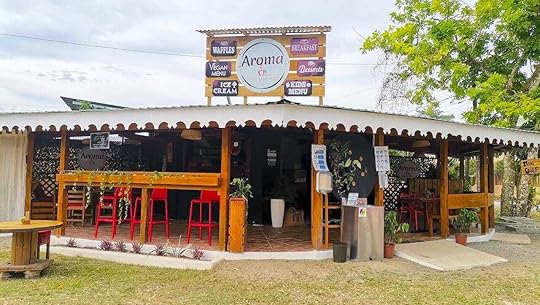
Photo: Aroma, Coffee Bar & Breakfast/Facebook
El Rincon del Amor is a friendly and hospitable restaurant specializing in freshly caught seafood with a Caribbean twist. The chef conjures up such temptations as garlic shrimp, Caribbean chicken, and red snapper. Portions are substantial and free shots of tequila are all part of the service.
As far as settings go, Sobre las Olas, situated just east of Playa Negra, is unbeatable. Watch the sun sink over the ocean while indulging in freshly caught grilled fish. There are plenty of vegan options too, and the menu is both Caribbean and Italian inspired. Tables and chairs are set on the beach amongst the palm trees.
If you are headed to the national park for the day, Aroma is the place to pick up sandwiches and other snacks for your excursion. It’s also a good breakfast spot, serving the best coffee in town and various offerings from pancakes to a full breakfast. Veggie options are available too, and you shouldn’t leave Cahuita without checking out the very special mango smoothies.
Where to stay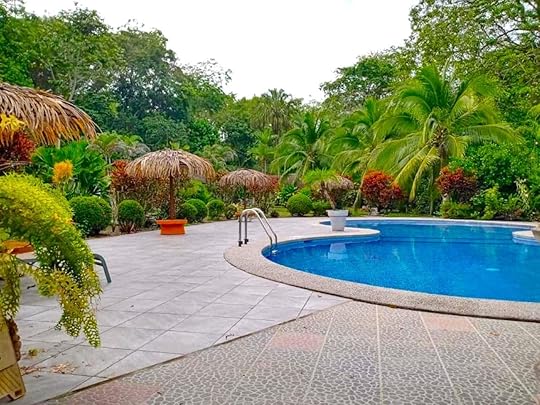
Photo: Suizo Loco Lodge/Facebook
Cahuita seriously lacks in luxury hotels, and that is what makes it so appealing. Most of the hotels and guest houses are enhanced by the natural environment that they are situated in, and guests are as likely to spot monkeys in the lush surrounding gardens as in the national park.
Although the accommodation at La Piscina Natural is fairly basic, it is set right on the beach with its own natural pool and lovely gardens complete with the obligatory hammocks. It’s located a twenty-minute walk from town at Playa Negra, and the delightful owners, Patty and Walter, are welcoming and helpful. La Piscina Natural is an affordable slice of paradise by the Caribbean and a perfect budget option.
Mid-range Suizo Loco Lodge has bungalows grouped around a pool. There’s an onsite restaurant, and all rooms have their own terrace overlooking the gardens. The highlight of a stay here is drinking cocktails on a lounger while surrounded by toucans, hummingbirds, and howler monkeys.
A stay in Topo’s Treehouse is a unique experience. This double-decked treehouse, built into a giant coniferous tree, lies in the heart of the jungle, a short walk from the beach. Accommodating four people, it is beautifully crafted and comfortable. You can look out across the treetops and over a lily pond and spot local wildlife from the terrace.
How to get to CahuitaBuses leave from Terminal Atlantico on Avenue 7/9, Calle 12 in the capital city of San Jose five times a day and take around 5-6 hours, depending on traffic and road conditions. More expensive shuttle buses are also available from San Jose Airport. 
The post At this Costa Rica hideaway, the real luxury is seeing abundant and rare wildlife appeared first on Matador Network.
This underwater light show near Orlando is all-natural and it will blow your mind
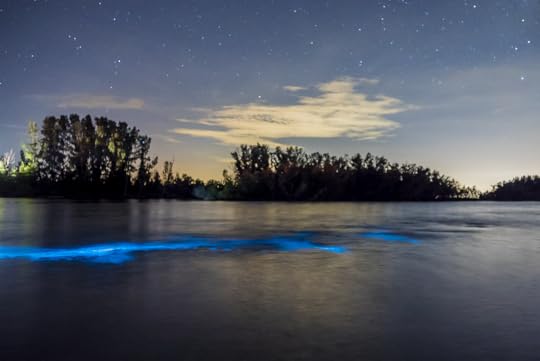
The area around Orlando, Florida, is known for thrill rides, Mickey Mouse ears, and crowds of tourists. What it’s not known for is the underwater light show that happens every year here from June to October. It’s during this time that the Merritt Island National Wildlife Refuge — 140,000 acres of water, islands, and marshlands off the east coast of Central Florida — puts on an exhilarating show of a whole different caliber.
The wild phenomenon, which you can reach within 45 minutes from the major theme parks, happens nightly and is a sight to see. Just ask , a Dominican Republic resident who visits central Florida often; she says it’s like paddling through the Milky Way.
She began the trip in earnest with her two sons, all on high alert for deer, raccoons, and hogs that tend to frequent the area. It was a warm night in June during a new moon, the perfect time to go. They arrived at the launch point around 10:00 PM, through a dirt-road entrance alongside the Indian River.
Here they met up with Get Up And Go Kayaking, an adventure outfitter that takes guests through the estuary in a see-through kayak, so it’s easy to see marine life right below you.
“Be prepared once you lose your phone signal to lower your speed and start enjoying the journey,” she says.
Before long they were in kayaks and paddling out. Turull de Alma says it didn’t take long to witness the bioluminescence. It happens night after night, not too far offshore, when the water is warm. During the one-and-a-half-hour tour, they spotted jellyfish, dolphins, manatees and fish, all glowing neon blue.
“It’s a magical, immersive experience that nature gives us as a gift,” she says.
What exactly causes this phenomenon? It’s all thanks to dinoflagellates, single-celled organisms, that bloom here annually.
“Bioluminescence is found in all the world’s oceans, surface to bottom and coast to coast,” says Edith Widder, founder of the Ocean Research & Conservation Association. “Out in the open ocean environment, away from shore more than 50 percent of the animals you bring up in a net can make light. It’s much less common in the coastal zone where the bioluminescence you see most often is caused by sea sparkle.” (Sea sparkle is a more common name for bioluminescent plankton).
Orlando resident Stephanie Patterson has experienced it, too. She says it’s like seeing shooting stars just below the surface. During her tour she went on with her mom, she was thrilled with the peacefulness of it. Ambient noise included the occasional boat motor and the splish-splash of her paddling repetitively cutting through the water.
Manatees, dolphins, and more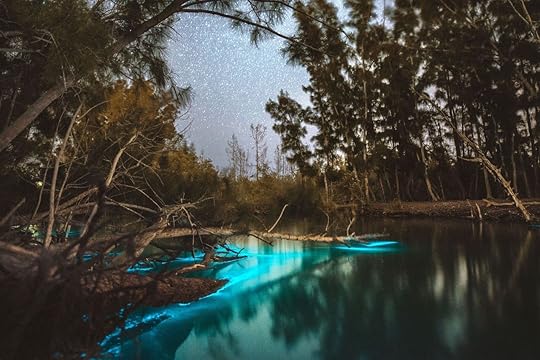
Photo: Tony Catalano
“It’s super common to see manatees,” says Justin Buzzi, owner of Get Up And Go Kayaking, who has led tours here for the past four years. “Because they glow bright blue when they pass by, people often mention that they look like submarines.”
“While they can be shy, it’s almost guaranteed you’ll be able to spot one on your tour, even if from afar,” Patterson adds.“ You’ll never forget what it felt like to kayak past a manatee lit up by a blue glow, or the freakish feeling of dipping your hand in the water and watching it glisten with bioluminescent organisms.”
The Merritt Island refuge is home to 1,500 plant and animal species. Among them are dolphins, which are as mesmerizing as the manatees. Buzzi says he once had a pod of about 20 dolphins pass by. When they exhaled, he could see the water spouting from their blowholes glowing neon blue.
This area also happens to be packed with mullets that tend to jump out of the water. In other words, be prepared for a mullet or two to land in your kayak.
Best times to goIt’s not inexpensive to see this eerie blue glow, at $74 for adults, $59 for kids up to 17, and free for under threes. But it’s clearly a magical experience.
As Patterson says, it was just as special to witness the celestial happenings. “Living in a densely populated area, the most striking aspect of kayaking at night within the refuge was the night sky,” Patterson says.
Because it was a clear, dark night when she went and because the 140,000-acre wildlife refuge has no light pollution, she had a stellar view of the Milky Way. That said, Buzzi says your best bet is to go on the darkest nights. He recommends a night with a 55 percent moon phase or less.
“Experiencing the bioluminescence in a clear kayak is a totally surreal experience because you’re suddenly engulfed in it from all angles,” Patterson recalls. “Instead of seeing the glow behind you or next to you, it’s suddenly surrounding you from all directions.”
If you have an option on which night to go, call ahead to find out what conditions are like to ensure a dark night. You should also wear bug spray, long pants, and long sleeves. Although the bioluminescent season typically lasts from June through October, the brightest months tend to be July and August. See the moon-phase calendar here. 
The post This underwater light show near Orlando is all-natural and it will blow your mind appeared first on Matador Network.
This carbon-neutral travel gear makes staying organized on the road crazy easy

Travel is on, and the team at Matador is ready to get back on the move. Admittedly, we’re a little rusty. Where is that tattered old passport, and why is there travel gear scattered across the garage?
Peak Design appears to have planned for such disarray. Their new line of carry-on travel gear is built to alleviate the common misplacing that would otherwise be inevitable as the world works back towards its travel routine. We’ve particularly come to love their new travel backpack, packing cubes, and wash pouch. In an ultimate win-win, the brand makes carbon-neutral travel gear — so you’re doing the planet a solid with your purchase as well. We’ve linked to each here through REI, so you can even add to your membership dividend while optimizing your travel setup.
We hope you love the travel gear we recommend! Just so you know, Matador may collect a small commission from the links on this page if you decide to make a purchase. Listed prices are accurate as of the time of publication. See our full Advertiser Disclosure here.
Peak Design Travel Backpack 45L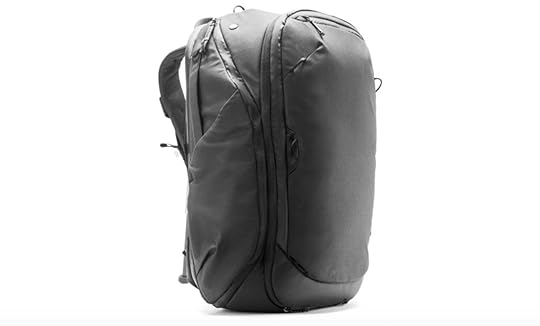
Photo: Peak Design
What we love about Peak Design is their firm understanding that no two trips are the same. This carry-on-sized travel backpack packs a ton of stuff while still saving the hassle of waiting in line to check a bag. In its 45 liters, you can easily fit enough rolled clothes for a week on the road along with toiletries, remote work gear, and the little things that vary from trip to trip. The Peak Design Travel Backpack is also lined with both internal and external pockets to store everything from your water bottle and coffee mug to the books and journal you’ll want to grab while on the plane. We’ve yet to find a more convenient travel backpack on the market.
Price: $299.95
Peak Design Packing Cubes for optimized organization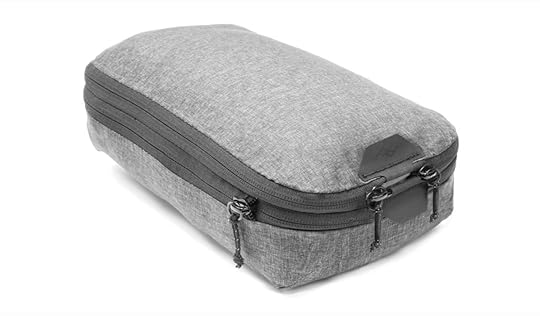
Photo: Peak Design
Of course, packing all that stuff in a carry-on backpack requires a firm grasp of optimized packing skills. This includes packing cubes that keep your clothes and other valuables organized so you know exactly where everything is, and can easily grab what you need when the time comes. What separates these Peak Design packing cubes from others on the market is that they are compressible. Expand or contract them to your needs, saving even more space on quick trips when you don’t need to bring as much. The Peak Design packing cubes are sized for the Peak Design travel backpacks but can fit comfortably in any suitcase or pack.
Price: $29.95
Peak Design Wash Pouch for toiletries and small items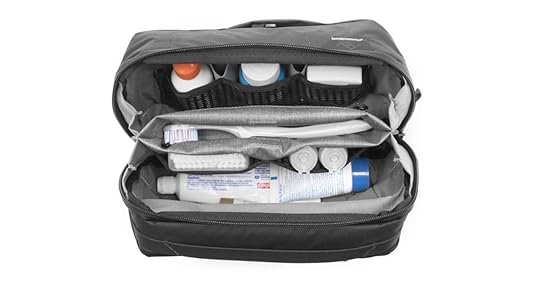
Photo: Peak Design
No travel setup is complete without a good wash pouch. Fortunately, gone are the days when TSA required a clear plastic toiletry pouch to get through security without answering questions. We’ve loved settling into the Peak Design Wash Pouch. It unzips to provide easy viewing and access to everything from deodorant to skin care, and should a bit of toothpaste become smeared on its inside, the pouch easily turns inside-out for cleaning. The Peak Design Wash Pouch even comes with designated toothbrush and razor pockets. You’ll never leave either behind in a hotel bathroom again. 
Price: $59.95
More like thisWhere to Stay6 blissful boutique hotels in Maui you can still book this summer and fallThe post This carbon-neutral travel gear makes staying organized on the road crazy easy appeared first on Matador Network.
Matador Network's Blog
- Matador Network's profile
- 6 followers



